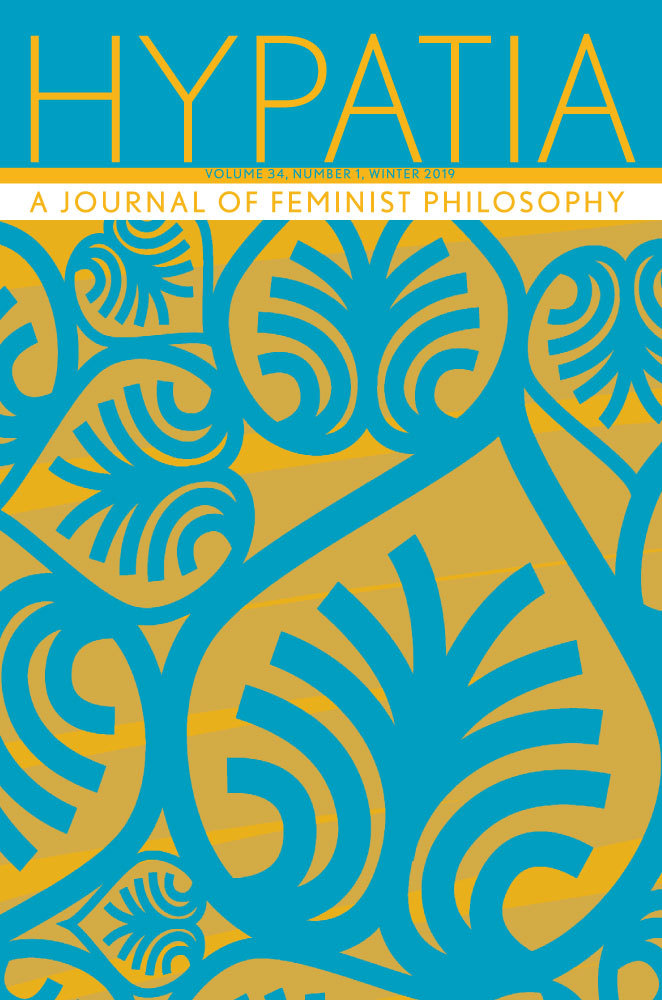Original Article
Epistemic Violence and Emotional Misperception
Abstract
I expand upon Kristie Dotson's concept of “epistemic violence” by identifying another type of epistemic violence that arises in the context of nonverbal communication. “Emotional misperception,” as I call it, occurs when the following conditions are met: (1) A misreads B's nonlinguistic expression of emotion, (2) owing to reliable ignorance, (3) harming B.
References
- Ahmed, Sara. 2010. The promise of happiness. Durham, N.C.: Duke University Press.
10.1215/9780822392781 Google Scholar
- Barrett, Lisa F. 2006. Emotions as natural kinds? Perspectives on Psychological Science 1 (1): 28–58.
- Barrett, Lisa F., and Eliza Bliss-Moreau. 2009. She's emotional. He's having a bad day. Attributional explanations for emotion stereotypes. Emotion 9 (5): 649–58.
- Blum, Lawrence. 2004. Stereotypes and stereotyping: A moral analysis. Philosophical Papers 33 (3): 251–89.
10.1080/05568640409485143 Google Scholar
- Campbell, Sue. 1994. Being dismissed: The politics of emotional expression. Hypatia 9 (3): 46–65.
- Cardwell, Mike. 2014. Dictionary of psychology. New York: Routledge.
10.4324/9781315061931 Google Scholar
- Collins, Patricia Hill. 2008. Black feminist thought. New York: Routledge.
- Darwin, Charles. 2009. The expression of the emotions in man and animals. New York: Oxford University Press.
10.1017/CBO9780511694110 Google Scholar
- de Gelder, Beatrice. 2016. Emotions and the body. New York: Oxford University Press.
10.1093/acprof:oso/9780195374346.001.0001 Google Scholar
- Dotson, Kristie. 2011. Tracking epistemic violence, tracking practices of silencing. Hypatia 26 (2): 236–57.
- Eccles, Jacquelynne S., Janice E. Jacobs, and Rena D. Harold. 1990. Gender role stereotypes, expectancy effects, and parents’ socialization of gender differences. Journal of Social Issues 46 (2): 183–201.
- Ekman, Paul. 1992. An argument for basic emotions. Cognition and Emotion 6 (3/4): 169–200.
- Ekman, Paul. 2016. What scientists who study emotion agree about. Perspectives on Psychological Science 11 (1): 31–34.
- Ekman, Paul, and Wallace V. Friesen. 2003. Unmasking the face. Los Altos, Calif.: Malor Books.
- Elfenbein, Hillary A., and Nalini Ambady. 2002a. On the universality and cultural specificity of emotion recognition: A meta-analysis. Psychological Bulletin 128 (2): 205–35.
- Elfenbein, Hillary A., and Nalini Ambady. 2002b. Is there an in-group advantage in emotion recognition? Psychological Bulletin 128 (2): 243–49.
- Elfenbein, Hillary A., Martin Beaupré, Manon Lévesque, and Ursula Hess. 2007. Toward a dialect theory: Cultural differences in the expression and recognition of posed facial expressions. Emotion 7 (1): 131–46.
- Gebreyes, Rahel. 2015. How misperceptions of “aggressive” black female behavior lead to tough punishments for young girls. The Huffington Post, June 1. https://www.huffingtonpost.com/2015/06/01/punishments-black-girls-aggressive-behavior_n_7484356.html.
- Gitter, A. George, Harvey Black, and David Mostofsky. 1972. Race and sex in the perception of emotion. Journal of Social Issues 28 (4): 63–78.
- Green, Mitchell. 2007. Self-expression. New York: Oxford University Press.
10.1093/acprof:oso/9780199283781.001.0001 Google Scholar
- Grice, Herbert Paul. 1957. Meaning. Philosophical Review 66 (3): 377–88.
- Harlow, Roxanna. 2003. “Race doesn't matter, but…”: The effect of race on professors’ experiences and emotion management in the undergraduate college classroom. Social Psychology Quarterly 66 (4): 348–63.
- Harris, Trudier. 1982. From mammies to militants. Philadelphia: Temple University Press.
- Henley, Nancy. 1977. Body politics: Power, sex, and nonverbal communication. Upper Saddle River, N.J.: Prentice-Hall.
- Hochschild, Arlie. 1983. The managed heart. Oakland: University of California Press.
- hooks, bell. 1984. Feminist theory: From margin to center. Boston: South End Press.
- hooks, bell. 1996. Killing rage: Ending racism. New York: Henry Holt and Company.
- Hornsby, Jennifer. 1995. Disempowered speech. Philosophical Topics 23 (2): 127–47.
10.5840/philtopics199523211 Google Scholar
- Jack, R. E., O. G. B. Garrod, H. Yu, R. Caldara, and P. G. Schyns. 2012. Facial expressions of emotion are not culturally universal. PNAS 109 (19): 7241–44.
- Kilbride, J. E., and M. Yarczower. 1983. Ethnic bias in the recognition of facial expressions. Journal of Nonverbal Behavior 8 (1): 27–41.
- Kirouac, G., and U. Hess. 1999. Group membership and the decoding of nonverbal behavior. In The social context of nonverbal behavior, ed. P. Philippot, R. Feldman, and E. Coats. New York: Cambridge University Press.
- Kukla, Rebecca. 2014. Performative force, convention, and discursive injustice. Hypatia 29 (2): 440–57.
- Kukla, Rebecca, and Mark Lance. 2009. “Yo!” and “lo!”: The pragmatic topography of the space of reasons. Cambridge, Mass.: Harvard University Press.
- Lorde, Audre. 1984. Sister outsider. Trumansburg, N.Y.: The Crossing Press.
- Machida, Sandra. 1986. Teacher accuracy in decoding nonverbal indicants of comprehension and noncomprehension in Anglo- and Mexican-American children. Journal of Educational Psychology 78 (6): 454–64.
- Maitra, Ishani. 2009. Silencing speech. Canadian Journal of Philosophy 39 (2): 309–38.
- Matsumoto, David, and Bob Willingham. 2009. Spontaneous facial expressions of emotion in congenitally and noncongenitally blind individuals. Journal of Personality and Social Psychology 96 (1): 1–10.
- Mehrabian, A., and M. Wiener. 1967. Decoding of inconsistent communications. Journal of Personality and Social Psychology 6 (1): 109–14.
- Plant, E. Ashby, Janet S. Hyde, Dacher Keltner, and Patricia G. Devine. 2000. The gender stereotyping of emotions. Psychology of Women Quarterly 24 (1): 81–92.
- Plant, E. Ashby, Kristen C. Kling, and Ginny L. Smith. 2004. The influence of gender and social role on the interpretation of facial expressions. Sex Roles 51 (3/4): 187–96.
- Russell, James A. 1994. Is there universal recognition of emotion from facial expression? A review of cross-cultural studies. Psychological Bulletin 115 (1): 102–41.
- Spelman, Elizabeth V. 1989. Anger and insubordination. In Women, knowledge, and reality, ed. A. Garry and M. Pearsall. Boston: Unwin Hyman.
- Stein, Timo, Marius V. Peelen, Johanna Funk, and Katharina N. Seidl. 2010. The fearful-face advantage is modulated by task demands: Evidence from the attentional blink. Emotion 10 (1): 136–40.
- Wilson, John Paul, Kurt Hugenberg, and Nicholas O. Rule. 2017. Racial bias in judgments of physical size and formidability: From size to threat. Journal of Personality and Social Psychology 113 (1): 59–80. http://psycnet.apa.org/record/2017-11085-001.




